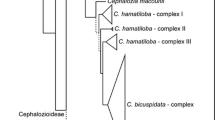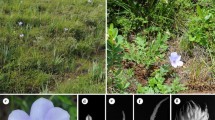Abstract
Although a worldwide phylogeny of the bolbitidoid fern genus Elaphoglossum is now available, little is known about the phylogenetic position of the 34 Cuban species. We performed a phylogenetic analysis of a chloroplast DNA dataset for atpß-rbcL (including a fragment of the gene atpß), rps4-trnS, and trnL-trnF. The dataset included 79 new sequences of Elaphoglossum (67 from Cuba) and 299 GenBank sequences of Elaphoglossum and its most closely related outgroups, the bolbitidoid genera Arthrobotrya, Bolbitis, Lomagramma, Mickelia, and Teratophyllum. We obtained a well-resolved phylogeny including the seven main lineages recovered in previous phylogenetic studies of Elaphoglossum. The Cuban endemic E. wrightii was found to be an early diverging lineage of Elaphoglossum, not a member of E. sect. Squamipedia where it was previously classified. We propose a new section for this species: E. sect. Wrightiana. The early diverging position of E. wrightii is of particular interest because the species is a root climber (i.e., climbing from the soil on the lower portions of tree trunks and not losing its connection with the soil), a growth habit it shares with its closest bolbitidoid outgroup genera. This suggests that holoepiphytism evolved later in Elaphoglossum, and the primary hemiepiphytism of E. amygdalifolium, which is sister to the rest of the genus, was derived independently from ancestors that were root climbers. Based on our phylogenetic analysis and morphological investigations, the species of Cuban Elaphoglossum were found to occur in E. sects. Elaphoglossum, Lepidoglossa, Polytrichia, Setosa, and Squamipedia.




Similar content being viewed by others
References
Anderson WR, Anderson C (1985) Elaphoglossum. In: Proctor GR (ed) Ferns of Jamaica. British Museum of Natural History, London, pp 486–518
Caluff MG, Sánchez C, Shelton G (2008) Helechos y plantas afines (Pteridophyta) de Cuba. I. Fitogeografía. Rev Jard Bot Nac 29:21–49
Darwin C (1865) On the movements and habits of climbing plants. J Linn Soc Bot 9:1–118
Eastwood A, Cronk QCB, Vogel JC, Hemp A, Gibby M (2004) Comparison of molecular and morphological data on St. Helena: Elaphoglossum. Pl Syst Evol 245:93–106
Edgar RC (2004) MUSCLE: multiple sequence alignment with high accuracy and high throughput. Nucl Acids Res 32:1792–1797
Feldberg K, Váňa J, Long DG, Shaw AJ, Hentschel J, Heinrichs J (2010) A phylogeny of Adelanthaceae (Jungermanniales, Marchantiophyta) based on nuclear and chloroplast DNA markers, with comments on classification, cryptic speciation and biogeography. Molec Phylogen Evol 55:293–304
Felsenstein J (1985) Confidence limits on phylogenies: an approach using the bootstrap. Evolution 39:783–791
Gebelein J (2012) A geographic perspective of Cuban landscapes. Landscape. Springer, New York
Hall TA (1999) BioEdit: a user-friendly biological sequence alignment editor and analysis program for Windows 95/98/NT. Nucl Acids Symp Ser 41:95–98
Hillis DM, Bull JJ (1993) An empirical test of bootstrapping as a method for assessing the confidence in phylogenetic analysis. Syst Biol 42:182–192
Huelsenbeck JP, Ronquist F (2001) MRBAYES: Bayesian inference of phylogenetic trees. Bioinforma 17:754–755
Janssen T, Kreier H-P, Schneider H (2007) Origin and diversification of African ferns with special emphasis on Polypodiaceae. Brittonia 59:159–181
Kessler M, Mickel J (2006) Nineteen new species of Elaphoglossum (Elaphoglossaceae, Pteridophyta) from Bolivia. Brittonia 58:93–118
Lagomarsino L, Grusz A, Moran RC (2012) Primary hemiepiphytism and gametophyte morphology in Elaphoglossum amygdalifolium (Dryopteridaceae). Brittonia 64:226–235
Lanfear R, Calcott B, Ho SYW, Guindon S (2012) PartitionFinder: combined selection of partitioning schemes and substitution models for phylogenetic analyses. Mol Biol Evol 29:1695–1701
Larget B, Simon DL (1999) Markov chain Monte Carlo algorithms for the Bayesian analysis of phylogenetic trees. Mol Biol Evol 16:750–759
Mickel JT (1995) Elaphoglossum. In: Moran RC, Riba R (eds) Flora Mesoamericana, vol I. Psilotaceae a Salviniaceae. Universidad Nacional Autónoma de México, México, D. F., pp 250–283
Mickel JT, Atehortúa LG (1980) Subdivision of the genus Elaphoglossum. Am Fern J 70:47–68
Mickel JT, Smith AR (2004) Elaphoglossum. In: Mickel JT, Smith AR (eds) The Pteridophytes of Mexico. Memoris of the New York Botanical Garden, vol 88. New York Botanical Garden Press, New York, pp 282–315
Moran RC (2008) Diversity, biogeography, and floristics. In: Ranker TA, Haufler CH (eds) Biology and evolution of ferns and lycophytes. Cambridge University Press, New York, pp 367–394
Moran RC, Smith AR (2001) Phytogeographic relationships between neotropical and African-Madagascan pteridophytes. Brittonia 53:304–351
Moran RC, Hanks JG, Rouhan G (2007) Spore morphology in relation to phylogeny in the fern genus Elaphoglossum (Dryopteridaceae). Int J Pl Sci 168:905–929
Moran RC, Labiak PH, Sundue M (2010a) Phylogeny and character evolution of the bolbitidoid ferns (Dryopteridaceae). Int J Pl Sci 171:547–559
Moran RC, Labiak PH, Sundue M (2010b) Synopsis of Mickelia, a newly recognized genus of bolbitidoid ferns (Dryopteridaceae). Brittonia 62:337–356
Proctor GR (1977) Elaphoglossum. In: Proctor GR (ed) Flora of the Lesser Antilles: Leeward and Windward Islands, vol 2. Pteridophyta. Arnold Arboretum, Harvard University, Massachusetts, pp 197–217
Proctor GR (1989) Elaphoglossum. In: Proctor GR (ed) Ferns of Puerto Rico and the Virgin Islands. Memoris of the New York Botanical Garden, vol 53. New York Botanical Garden Press, New York, pp 289–301
Renner S (2004) Tropical trans-Atlantic disjunctions, sea surface currents, and wind patterns. Int J Pl Sci 165:S23–S33
Ricklefs RE, Bermingham E (2008) The West Indies as a laboratory of biogeography and evolution. Phil Trans R Soc B Biol Sci 363:2393–2413
Rouhan G, Dubuisson J-Y, Rakotondrainibe F, Motley TJ, Mickel JT, Labat J-N, Moran RC (2004) Molecular phylogeny of the fern genus Elaphoglossum (Elaphoglossaceae) based on chloroplast non-coding DNA sequences: contributions of species from the Indian Ocean area. Molec Phylogen Evol 33:745–763
Rouhan G, Rakotondrainibe F, Moran RC (2007) Elaphoglossum nidusoides (Dryopteridaceae), a new species of fern from Madagascar with an unusual phylogenetics position in the Squamipedia group. Syst Bot 32:227–235
Rouhan G, Lorence DH, Motley TJ, Hanks JG, Moran RC (2008) Systematic revision of Elaphoglossum (Dryopteridaceae) in French Polynesia, with the description of three new species. Bot J Linn Soc 158:309–331
Roux JP (2011) The fern genus Elaphoglossum section Lepidoglossa (Dryopteridaceae) in Africa, Macaronesia, the mid-Atlantic and southern Indian Ocean Islands. Bot J Linn Soc 165:20–63
Schneider H, Kreier H-P, Janssen T, Otto E, Muth H, Heinrichs J (2010) Key innovations versus key opportunities: identifying causes of rapid radiations in derived ferns. In: Glaubrecht M (ed) Evolution in action. Springer, Berlin, Heidelberg, pp 61–75
Skog JE, Mickel JT, Moran RC, Volovsek M, Zimmer EA (2004) Molecular studies of representative species in the fern genus Elaphoglossum (Dryopteridaceae) based on cpDNA sequences rbcL, trnL-F, and rps4-trnS. Int J Pl Sci 165:1063–1075
Stamatakis A (2006) RAxML-VI-HPC: maximum likelihood-based phylogenetic analyses with thousands of taxa and mixed models. Bioinformatics 22:2688–2690
Swofford DL (2000) PAUP*. Phylogenetic analysis using parsimony (*and other methods). Sinauer Associates, Sunderland
Tamura K, Peterson D, Peterson N, Stecher G, Nei M, Kumar S (2011) MEGA5: molecular evolutionary genetics analysis using maximum likelihood, evolutionary distance, and maximum parsimony methods. Mol Biol Evol 28:2731–2739
Vasco A (2011) Taxonomic revision of Elaphoglossum section Muscosa (Dryopteridaceae). Blumea 56:165–202
Vasco A, Moran RC, Rouhan G (2009a) Circumscription and phylogeny of the Elaphoglossum ciliatum group (E. sect. Lepidoglossa, Dryopteridaceae) based on cpDNA sequences. Taxon 58:825–834
Vasco A, Moran RC, Rouhan G (2009b) Monograph of the Elaphoglossum ciliatum group (Dryopteridaceae). Brittonia 61:241–272
Vasco A, Mickel JT, Moran RC (2013) Monograph of the neotropical species of Elaphoglossum sect. Squamipedia (Dryopteridaceae). Ann Missouri Bot Gard (in press; accepted April 2013)
Yoder JB, Clancey E, Des Roches S, Eastman JM, Gentry L, Godsoe W, Hagey TJ, Jochimsen D, Oswald BP, Robertson J, Sarver BAJ, Schenk JJ, Spear SF, Harmon LJ (2010) Ecological opportunity and the origin of adaptive radiations. J Evol Biol 23:1581–1596
Acknowledgments
We thank the curators and directors of the herbaria B, BSC, BM, BR, G, GH, HAJB, K, M, MBG, NY, P, S, US, W and YU for access to collections and the loan of specimens. The first author’s visit to NY for herbarium and molecular phylogenetic research was supported by the Christopher Reynold Foundation, and we thank Brian Boom for his assistance in obtaining that grant. We also acknowledge a grant from the United States National Science Foundation (DEB 1020443) to R. C. Moran and B. A. Ambrose. The Swedish Institute granted funds for revising type specimens and additional material to L. Regalado. Financial support from the International Association of Plant Taxonomists to J. Lóriga, and further support from the Cuban Agency of Environment (CITMA, projects AMA204 and DB02) to J. Lóriga and L. Regalado, enabled field work in Cuba. We are grateful to Judith Garrison-Hanks for taking photomicrographs of the spores, and to Tynisha Smalls for helping with the molecular work at NY. Special thanks to Miguel Vences and Ariel Rodriguez for kindly providing advice on phylogenetic methods and access to the computer pool of the Zoological Institute of the Technical University of Braunschweig, and to John T. Mickel and Carlos Sánchez for discussions about Elaphoglossum. We are very grateful to two anonymous reviewers for their helpful comments on the manuscript.
Author information
Authors and Affiliations
Corresponding author
Rights and permissions
About this article
Cite this article
Lóriga, J., Vasco, A., Regalado, L. et al. Phylogeny and classification of the Cuban species of Elaphoglossum (Dryopteridaceae), with description of Elaphoglossum sect. Wrightiana sect. nov.. Plant Syst Evol 300, 937–951 (2014). https://doi.org/10.1007/s00606-013-0933-4
Received:
Accepted:
Published:
Issue Date:
DOI: https://doi.org/10.1007/s00606-013-0933-4




